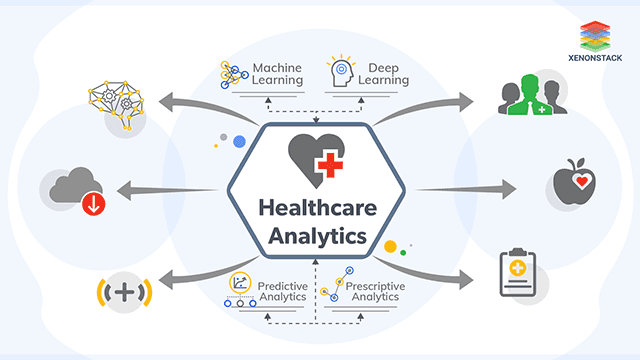Big Data has changed the way we manage and analyse data in any industry. The healthcare industry is a promising area where data analytics can be applied as it not only reduces costs, it can prevent diseases, predict epidemic outbreaks and improve overall life quality. The future of healthcare will therefore be driven by data analytics and digital transformation. In this blog post I will address why big data in healthcare is important and in what ways it can be applied.
Big data refers to vast quantities of information created by the digitization of everything that gets analysed by specific technologies. Data collection is critical in the healthcare industry. Doctors need to understand as much as possible about patients, as early as possible. Treating diseases at early stages is simpler and less expensive (Lebied, 2018). For years, health data collection has been very costly and time consuming. With today’s innovative technologies, it becomes easier to collect data and translate it to useful insights for better care. This not only reduces costs; it also makes a patient’s health situation more predictable (Lebied, 2018). This in turn enables insurance companies to tailor their packages based on this information.
Healthcare analytics can provide support in asking critical questions such as ‘What is the probability that this patient will recover within 6 months?’ or ‘How likely is this patient to suffer from complications if we perform this surgery’? Driven by the rise of Internet of Things (IoT) and Artificial Intelligence (AI) such as machine learning and robotics, we now have algorithms that can help us answer these questions (Philips, 2020). According to a 2019 survey, 60% of health executives recognize the benefits of healthcare analytics, and 42% of them have seen improved patient satisfaction (Kent, 2019). Below we see how healthcare organizations are using predictive analytics (Dé, 2019).

So in what ways do healthcare organizations apply analytics? Here are 3 examples of innovative technologies driven by healthcare analytics.
- Electronic Health Records (EHRs)
An EHR is a digital record of a patient’s demographics, medical history, allergies and more. These records are shared via secured systems and are available for providers from the public and private sector (Lebied, 2018). Leading healthcare organizations have integrated next generation analytics platforms into their EHR, such as algorithms and machine learning. This enables predictive, analytics- powered patient risk assessment. EHR can, for example, generate warnings and reminders when a patient should get a new test or when a patient is not following prescriptions.
- Precision Medicine
Precision Medicine (PM) is the most common application of machine learning in healthcare. It predicts what treatment protocols are likely to succeed on a patient, based on various attributes and the treatment context (Davenport & Kalakota, 2019). PM requires a training dataset for which the outcome variable is known, which is called supervised learning. Philips, the global leader in healthcare, for example applies PM to the field of oncology. PM will enable treatments to be tailored to genetic changes in each individual’s cancer (Philips, 2020). Cancer patients currently may receive a combination of treatments, while with PM, information about genetics can help doctors decide which treatment is best for each individual patient (Davenport & Kalakota, 2019).
- Real-Time Alerting
The traditional way of analysing medical data is facilitated through software that is only used in hospitals (Lebied, 2018). However, as in-house treatments are expensive, doctors want patients to stay away from hospitals as much as possible. To track patient data anytime and anywhere, real-time alerting is applied to wearables. These wearables collect the patient’s data continuously and send this data to the cloud (Knapp, 2018). An example is a blood pressure tracker, which alarms doctors when a patient’s blood pressure is too low or too high, so that appropriate action can be taken. This not only reduces in-house treatment costs; it also makes sure doctors can treat a patient as early as possible. What is more, it allows health executives to access the cloud with collected data to compare data in socioeconomic context and translate the data to useful insights (Lebied, 2018).
Evidently, the opportunities arising from healthcare analytics are very promising. Yet, as predictive analytics can be, their impact eventually depends on their knowledgeable use by health executives. The development of applications empowered by data analytics relies on the expert input. Another important note is that the issue of data privacy arises from the data driven nature of healthcare analytics. What will happen when data is shared seamlessly between different stakeholders? Should patients have control over what data is shared and with whom? The debate of how data can be shared without breaching patients’ trust is still ongoing.
References
Davenport, T., & Kalakota, R. (2019). The potential for artificial intelligence in healthcare. Future healthcare journal, 6(2), 94–98. https://doi.org/10.7861/futurehosp.6-2-94.
Dé, A., (2019). Why Healthcare Analytics Will Deliver More Results In 2019. [online] Biplatform.nl. Available at: <https://biplatform.nl/1826849/why-healthcare-analytics-will-deliver-more-results-in.html> [Accessed 7 October 2020].
Kent, J., (2019). 60% Of Healthcare Execs Say They Use Predictive Analytics. [online] HealthITAnalytics. Available at: <https://healthitanalytics.com/news/60-of-healthcare-execs-say-they-use-predictive-analytics> [Accessed 5 October 2020].
Knapp, J., (2018). Real-Time Healthcare Analytics: Monitor, Predict, Nudge, Act | Vocera. [online] Vocera.com. Available at: <https://www.vocera.com/blog/real-time-healthcare-analytics-monitor-predict-nudge-act> [Accessed 7 October 2020].
Lebied, M., (2018). 12 Examples Of Big Data In Healthcare That Can Save People. [online] BI Blog | Data Visualization & Analytics Blog | Available at: <https://www.datapine.com/blog/big-data-examples-in-healthcare/> [Accessed 5 October 2020].
Philips. (2020). Predictive Analytics In Healthcare: Three Real-World Examples. [online] Available at: <https://www.philips.com/a-w/about/news/archive/features/20200604-predictive-analytics-in-healthcare-three-real-world-examples.html> [Accessed 6 October 2020].

